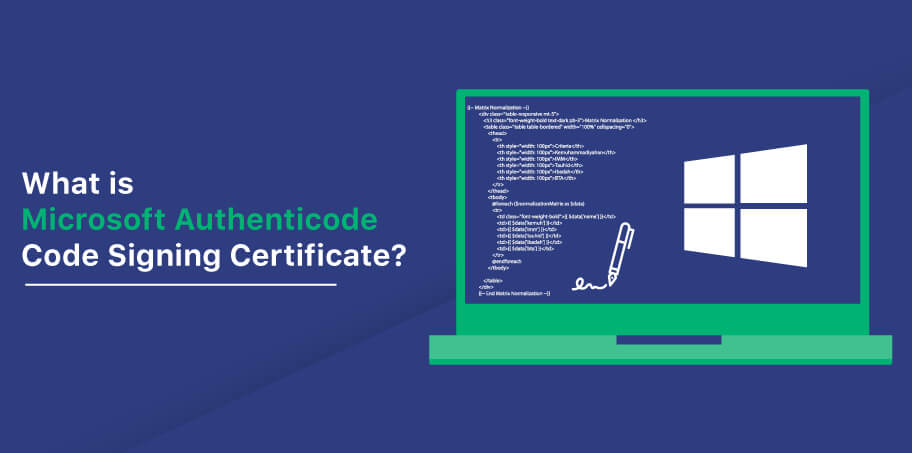What is Microsoft Authenticode Code Signing Certificate? [A Detailed Guide]

Cyberattacks are one of the top threats to businesses. No matter if it was a decade ago or today, there is no report that says cyberattacks have decreased or something similar. Every year, various top firms present their findings about cybersecurity, and it is worse than last year.
According to UpCity, the most common cause of cyberattacks is phishing and malware. And 20% of the companies do not have a cybersecurity plan to face it.
Some of you might be wondering, what does Authenticode Signing Certificate have to do with cyberattacks? Well, fake software carries malware, and fake software does not have a valid signature. If a code or software is signed by a valid code signing certificate from a CA, like DigiCert or Comodo, it will never raise a warning.
What is MS Authenti Code Signing Certificate?
Authenticode is a technology that is used by Microsoft for code signing. Code signing is a process where X.509 certificates are used to sign software codes, executable files, etc. The core motive behind this is to check the code and declare it as legit. Though it may seem a lot easier, it is not.
The code or the software file is checked by the system and verified against a list of reputed CAs. If the software code or file is code signed by a CA on the list, it is allowed to run. If not, an unknown publisher security warning is raised.
An unknown publisher warning informs the user that the software is not legit and they should not install it on their machine.
It can be used to sign almost all types of software and codes, such as .dll, .exe, .xpi, .cab, and more.
Here are some of the key features of the same!
- It completely supports the powerful SHA-2 Secure Hash Algorithm.
- No matter how many signatures you make, the feature of timestamping will always be there.
- It provides security for 32-bit and 64-bit kernel and user mode software.
- It is the ideal pick for Active-X controls, Plug-ins, and other exe files, if any.
- You can sign as many software codes as you want. There is no limit to it.
What is the Working?
Authenticode technology uses cryptographic methods to ensure the identity of the publisher (the maker of the software) and code integrity.
Here is a brief elaboration of both of these aspects!
Identity Verification
This is the step where the identity of the software publisher is verified. It links the digital signatures with the infrastructure of trusted certificate authorities. This is to ensure the users that the software is made by a legitimate publisher.
There are many publicly trusted certificate authorities that verify the authenticity of the applicant or entity before signing the software with a code signing certificate.
To ensure the identity of the applicant,
- The CAs check and validate the aspects of the publisher, like the business name, registration details, address, telephone number, and more.
- If you are an individual developer, you are required to provide a notarized form to validate your government-issued photo identification. On top of that, you are also required to complete a phone verification call.
Once the CA has validated your software, it can be easily installed by the users without facing any warning from their systems.
Integrity Assurance
Let’s assume that you produced the code of the software and you have made it public for the users. How do you know it is safe? What if it has been altered by a third-party hacker? To ensure that scenarios like these do not happen, you need to keep the code integrity intact.
The Authenti code hashes the digital signature of the publisher with the code. Thus, producing a hashing function. A hash function is produced when the data is altered or condensed based on a mathematical function. As each hash value is unique, it is easy to catch if it has been altered in any way.
If any cybercriminal tries to hack the software to inject malware, the hash function will be altered, and once it is altered, the digital signature changes. Now, when the users try to install the software, the browser or the PC will show a warning that the executable file has been tampered with.
Therefore, Microsoft saves users from getting exploited by fake software producers.

How to obtain a Microsoft Authenticode Code Signing Certificate?
There is no faster way to Buy Microsoft Authenticode Code Signing Certificate. It acts as a pivotal element in authenticating the software code. As long as the trust level in your organization is not developed, the CA will not issue you a code signing certificate.
Once the CA undertakes the comprehensive vetting process, it will issue you the certificate. Further, the level of vetting is also based on the type of certificate you want.
There are two types of certificates, namely
- Standard Code Signing Certificate
- Extended Validation (EV) Code Signing Certificate
In the case of a standard code signing certificate, the vetting process of the CA is not strict, Its light validation process.
In contrast to this, the EV Code Signing Certificate is a better choice for you, though the standard version is not bad too. The EV code signing certificate is provided after a comprehensive vetting process along with a private key stored in an external hardware token. With an EV certificate, you also get a reputation boost backed by the Microsoft SmartScreen filter.
Final Words
Ensures optimum code integrity and publisher identity. Further, it also has some of the best cryptography features, like hashing to keep the code and signature hidden.
Prove Your Identity to Your Users that the software is signed and published by Microsoft Authenticode Code Signing Certificate, Get it at $199.99/yr.
